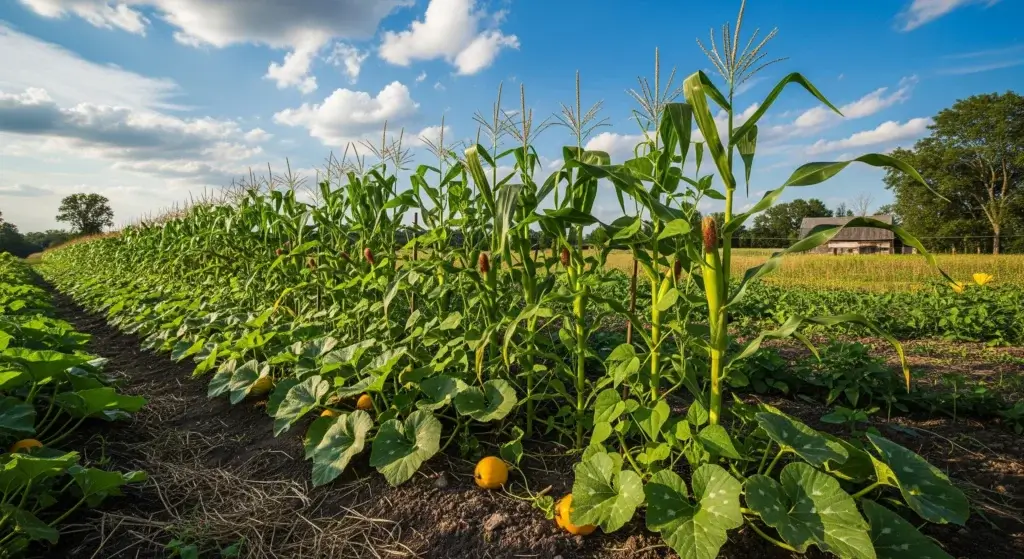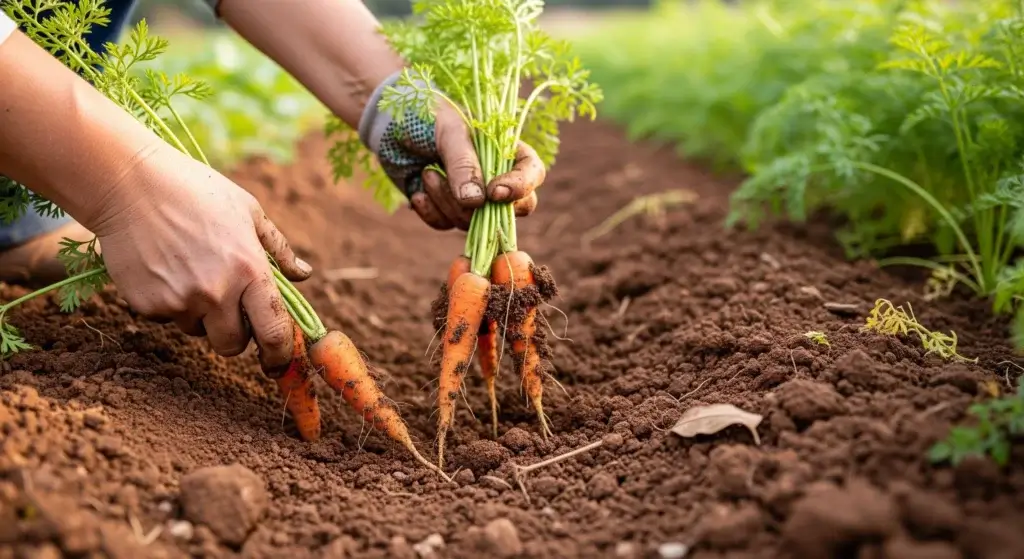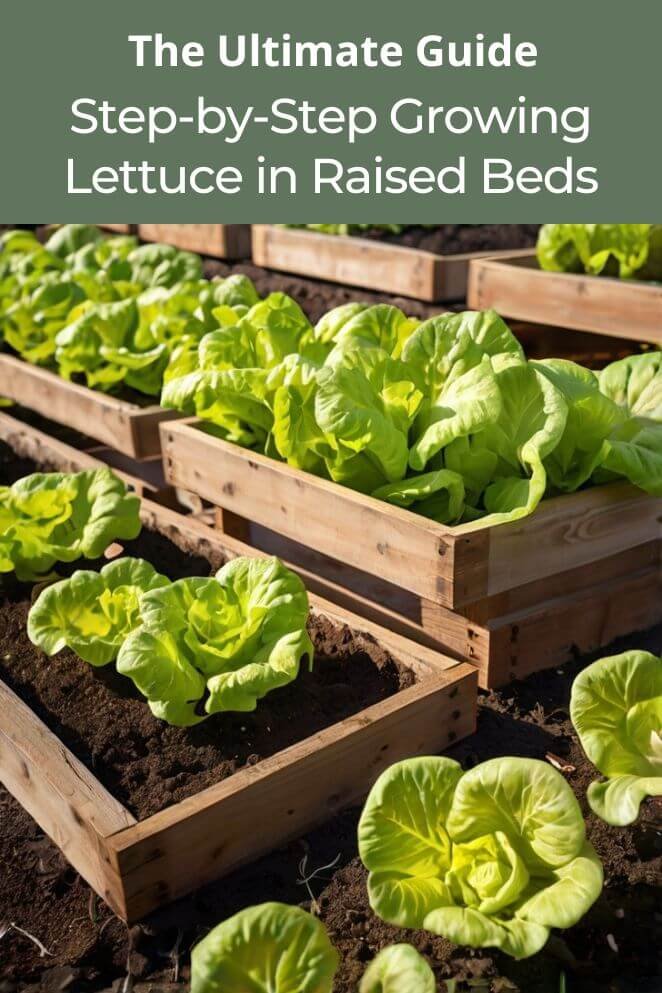
Lettuce is a versatile and nutritious leafy green that grows exceptionally well in a raised bed garden.
Using this elevated planting method helps you avoid common issues found with ground-level gardening, like poor soil and weed problems.
This guide will explain how and when to grow lettuce in raised beds, covering everything from soil preparation to planting, care, and harvesting.
We’ll walk you through all the essentials to help you enjoy a successful and tasty lettuce crop.
Varieties of Lettuce for Raised Beds
Raised beds are an excellent environment for growing lettuce due to their improved soil conditions and drainage.
Here are some popular lettuce varieties to consider for your raised bed garden:
- Leaf lettuce: This type includes varieties like Black-seeded simpson and Red sails. It’s quick to mature and easy to harvest, making it perfect for beginners.
- Romaine lettuce: Varieties like Little gem and Paris island cos are known for their crunchy texture and upright growth habit. They’re excellent for salads and sandwiches.
- Butterhead lettuce: With soft, buttery leaves, varieties like Buttercrunch and Bibb are a favorite for their tender texture and mild flavor.
- Crisphead lettuce: This includes the familiar Iceberg lettuce. Though it requires a longer growing season, its crisp, dense heads are worth the wait.
- Batavian (summer crisp) lettuce: Varieties like Nevada and Sierra have a unique blend of crispness and tenderness, making them a versatile choice.

- Read also: Watering Lettuce in Pots: A Simple Guide for Beginners
- Read also: Tips for a Thriving Harvest: Watering Lettuce in the Garden
Lettuce Growth Stages
Lettuce goes through several distinct stages as it grows.
Understanding these stages can help you determine the best time for harvesting and identify potential problems.
Germination stage
Description: Lettuce seeds absorb water and undergo germination.
Adequate humidity, temperature, and oxygen are essential for successful germination.
The emergence of cotyledons (two small leaves) is a sign of germination, it takes 5-10 days.
Seedling stage
This stage lasts approximately 7-14 days.
During this stage, the seedlings develop their first true leaves, which are distinct from the initial cotyledon leaves.
The true leaves continue to expand, and the cotyledons eventually fall off.
Proper care, including appropriate light, temperature, and moisture, is necessary for optimal growth.
Thinning seedlings to ensure adequate spacing is also important.
Vegetative stage (Rosette, Cupping, and Heading)
This stage can last from 25-50 days for the rosette stage, 1 week for the cupping stage, and 20-45 days for the heading stage.
- Rosette stage: The leaves form a circular shape, and the plant starts to form a rosette shape. This stage varies based on lettuce variety, with romaine having long, upright leaves and butter lettuce displaying lower and more ruffled leaves.
- Cupping stage: A brief period where the leaves begin to curl inward before forming a dense head.
- Heading stage: The plant forms a dense head, with outer leaves curling inward to cover the plant’s small center leaves. This stage is crucial for harvesting.
Bolting stage
Duration of the bolting stage can vary based on environmental conditions.
This stage occurs when the plant is exposed to high temperatures or other environmental stresses, causing the sudden elongation of the lettuce plant’s flowering stalk.
Bolting marks the transition from vegetative to reproductive growth.
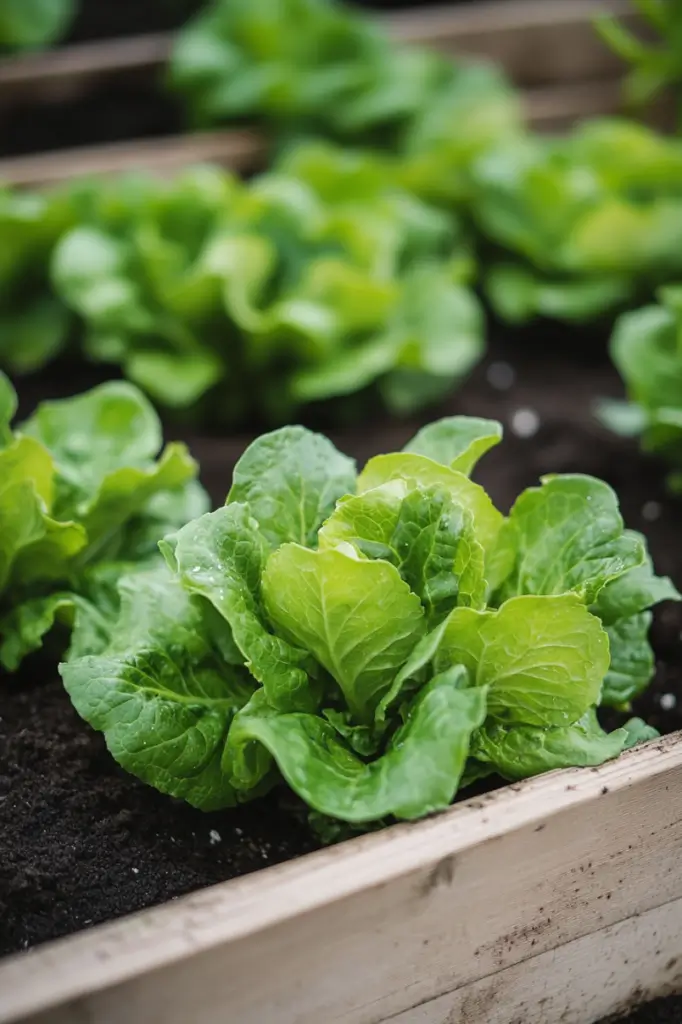
When to Plant Lettuce for Raised Beds
The best time to plant lettuce in raised beds depends on the climate and region you are in.
Lettuce thrives in cool weather, making it a great crop for spring and fall.
Here are some general guidelines:
- Early spring: Lettuce can be planted in early spring, typically from late winter to early spring, once the soil is free from snow. This is a good time for lettuce as the weather is still relatively cool, and the seeds can germinate in temperatures as low as 40°F (4°C) .
- Late spring: For warmer climates, late spring is also a suitable time to plant lettuce. This allows the crop to mature before the heat of summer sets in, which can cause lettuce to bolt (go to seed) and become bitter .
- Fall: Lettuce can also be planted in the fall, about 8 weeks before the first frost date. This allows for a second crop before the winter sets in.
How to Plant Lettuce in Raised Beds
Here is a step-by-step guide on how to plant lettuce in raised beds.
Follow these steps for a successful crop:
Step 1: Prepare raised bed
Fill your raised bed with high-quality soil rich in organic matter.
A mix of compost, peat moss, and vermiculite works well.
Loosen the top few inches of soil to improve drainage.
Remove any weeds or debris.
Step 2: Planting
Planting seeds
Create shallow furrows about 1/4 inch deep and space seeds according to package instructions.
Sow seeds directly into the prepared soil.
Cover seeds lightly with soil, lettuce seeds require light to germinate, so don’t bury them too deep.
Planting transplants
Dig holes slightly larger than the transplant pots.
Carefully remove seedlings from pots and place them in the holes.
Fill in with soil and gently firm around the roots.
Step 3: Watering
Gently water the area, keep the soil consistently moist but not waterlogged.
Step 4: Maintain seedlings
- Thinning: Once seedlings emerge, thin them out to about 6 inches apart. This will help prevent overcrowding and promote healthy growth
- Protecting from pests: Cover seedlings with row covers to protect them from birds and insects. Consider using organic pest control methods like companion planting or insecticidal soap.
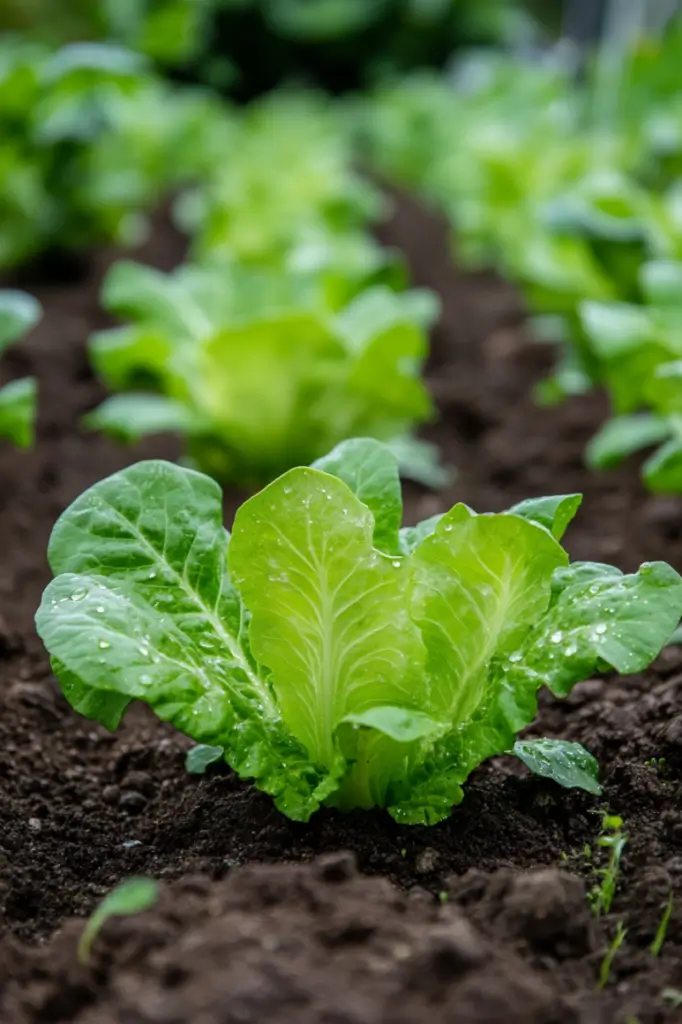
Caring for Lettuce in Raised Beds
Proper care is crucial for a bountiful lettuce harvest.
Lettuce is a relatively low-maintenance crop, but paying attention to its needs can greatly improve your yield.
Here are some detailed tips for caring for your lettuce in raised beds:
Watering
Lettuce has shallow roots and needs consistent moisture to grow well.
Aim to give it 1-2 inches of water each week.
If it’s dry or hot, you might need to water more often.
Make sure to water the soil rather than the leaves to avoid fungal diseases.
Use a watering can with a fine spout or a gentle spray nozzle to keep from disturbing the soil and plants.
Watering early in the morning helps reduce evaporation and lets the leaves dry out before evening, which helps prevent diseases.
Weeding
It’s important to keep weeds out of your raised bed to ensure your lettuce grows well.
Weeds compete with lettuce for nutrients, water, and sunlight.
Regularly check your beds and remove any weeds as soon as you spot them.
This stops weeds from taking over and competing with your lettuce.
Just be sure to avoid disturbing the roots of your lettuce while you’re weeding.
Fertilizing
Lettuce benefits from regular feeding to support its fast growth.
Here are some tips for fertilizing your lettuce:
- Balanced fertilizer: Use a balanced, slow-release fertilizer or organic compost to provide a steady supply of nutrients.
- Avoid high-nitrogen fertilizers: High-nitrogen fertilizers can cause lettuce leaves to become bitter. Opt for balanced formulas that support overall plant health.
- Application: Apply fertilizer according to the package instructions, usually once at planting and then every 3-4 weeks during the growing season. If using compost, work it into the top few inches of soil before planting.
Mulching
Mulching is a great method for keeping soil moisture, controlling weeds, and managing soil temperature.
Organic mulches such as straw, shredded leaves, or grass clippings work well.
These materials decompose over time, enriching the soil with nutrients.
Spread a 1-2 inch layer of mulch around your lettuce plants but avoid placing it directly against the stems to prevent rot.
Mulch helps maintain a cool and moist soil environment, which is crucial for lettuce, especially in hot weather.
Pest control
Lettuce can be susceptible to various pests, including aphids, slugs, and snails.
Here are some steps to control them:
- Aphids: Aphids can be found on the undersides of leaves. Control aphids by spraying plants with a mixture of water and mild soap, or use neem oil as a natural insecticide.
- Slugs and snails: These pests are attracted to the tender leaves of lettuce. Handpick them in the early morning or late evening. You can also use diatomaceous earth around your plants, which deters these pests by creating a barrier they avoid.
- Companion planting: Plant herbs like mint, basil, or rosemary nearby to repel pests naturally.
- Regular inspection: Check your plants regularly for signs of pest damage and take action immediately if you spot any issues.
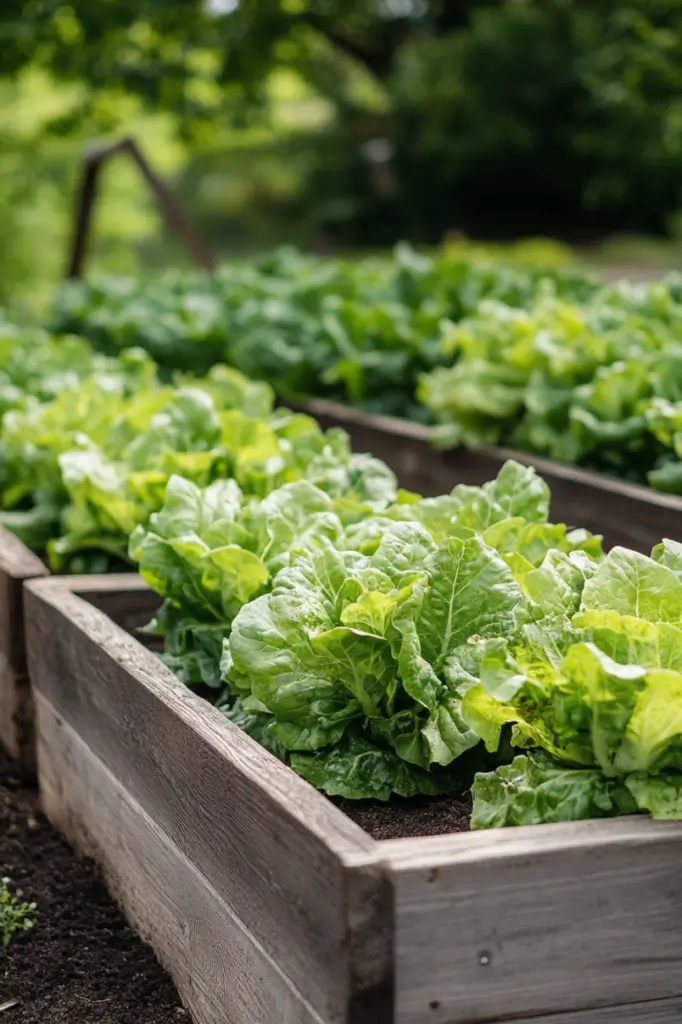
Common Problems When Growing Lettuce in Raised Beds
Even with the best care, you might encounter some issues when growing lettuce in raised beds.
Identifying and addressing these problems early can help ensure a healthy and productive crop.
Here are some common problems and their solutions:
Bolting
Bolting happens when lettuce plants begin to grow a flower stalk.
This typically occurs due to high temperatures (above 75°F), extended daylight hours, and lack of water.
Once lettuce bolts, the leaves turn bitter and aren’t good to eat. Here are some steps you can take to prevent bolting:
- Heat-resistant varieties: Plant varieties that are resistant to bolting, such as ‘Summertime’ or ‘Jericho’.
- Timing: Plant lettuce in early spring or late summer to avoid the hottest part of the year.
- Shade: Provide shade during hot weather using shade cloth or planting taller companion plants to cast a shadow.
- Watering: Keep the soil consistently moist to reduce stress on the plants.
Nutrient deficiency
Nutrient deficiencies can show up in different ways, and one common sign is yellowing leaves.
This usually means there’s a lack of nitrogen.
You’ll notice that the older leaves turn yellow while the new ones stay a light green.
Here’s what you can do to fix it:
- Fertilization: Use a balanced fertilizer or an organic compost to provide essential nutrients. Avoid high-nitrogen fertilizers that can cause bitter leaves.
- Soil testing: Conduct a soil test to determine nutrient levels and amend the soil accordingly.
Tipburn
Symptoms of tipburn are browning at the edges of lettuce leaves or dark/slimy leaves.
To overcome this issue, provide plenty of water, plant only in the spring and fall, and choose varieties resistant to tipburn.
Varieties like Starfighter, Green Forest, and Tropicana are good options.
Leggy lettuce
Tipburn shows up as browning at the edges of lettuce leaves or dark, slimy leaves.
To prevent this, make sure your plants get plenty of water.
It’s best to grow lettuce in the cooler seasons of spring and fall.
Additionally, choosing tipburn-resistant varieties can help.
Good options include Starfighter, Green Forest, and Tropicana.
Head formation issues
Sometimes, lettuce heads don’t form properly.
To avoid this problem, make sure your lettuce plants get full sunlight, but provide some afternoon shade if you live in a hot area.
Keep the soil moist but not too wet, and water the plants regularly, aiming for 1 to 2 inches of water each week.
Check your soil’s pH and adjust it if needed so it’s between 6.2 and 6.8.
Plant the rows 12 to 15 inches apart to give the heads enough room to grow.
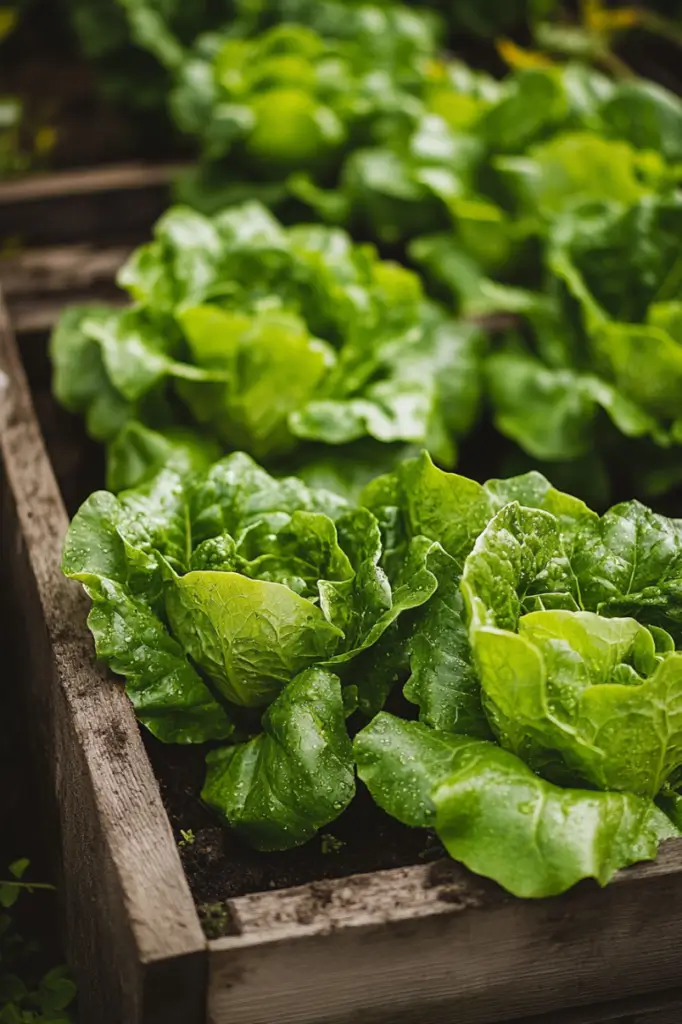
- Read also: The Ultimate Guide to Growing Lettuce in Containers
- Read also: A Beginner’s Guide: Tips for Growing Lettuce From Seed
How to Harvest Lettuce from Raised Beds
Harvesting lettuce is simple and rewarding. Here’s how:
- Leaf lettuce: Harvest outer leaves as needed, leaving the inner leaves to continue growing. This method, called “cut and come again,” provides a continuous supply.
- Head lettuce: For varieties like romaine or butterhead, wait until the head is fully formed. Cut the whole plant at the base with a sharp knife.
- Regular harvesting: Regular harvesting encourages new growth and prevents bolting. Check your lettuce daily during peak growing periods.
Conclusion
Growing lettuce in raised beds is a rewarding and straightforward process that can provide you with fresh, healthy greens throughout the growing season.
By choosing the right varieties, planting at the right time, and providing proper care, you can enjoy a bountiful harvest.
Remember to watch for common problems and harvest regularly to keep your lettuce productive and delicious.
FAQs
A raised bed should be at least 6-8 inches deep to accommodate lettuce roots.
Lettuce prefers cool weather, but you can grow heat-resistant varieties in partial shade during the summer.
Once lettuce bolts, it becomes bitter. You can pull up the plants and replant for a fall crop.

